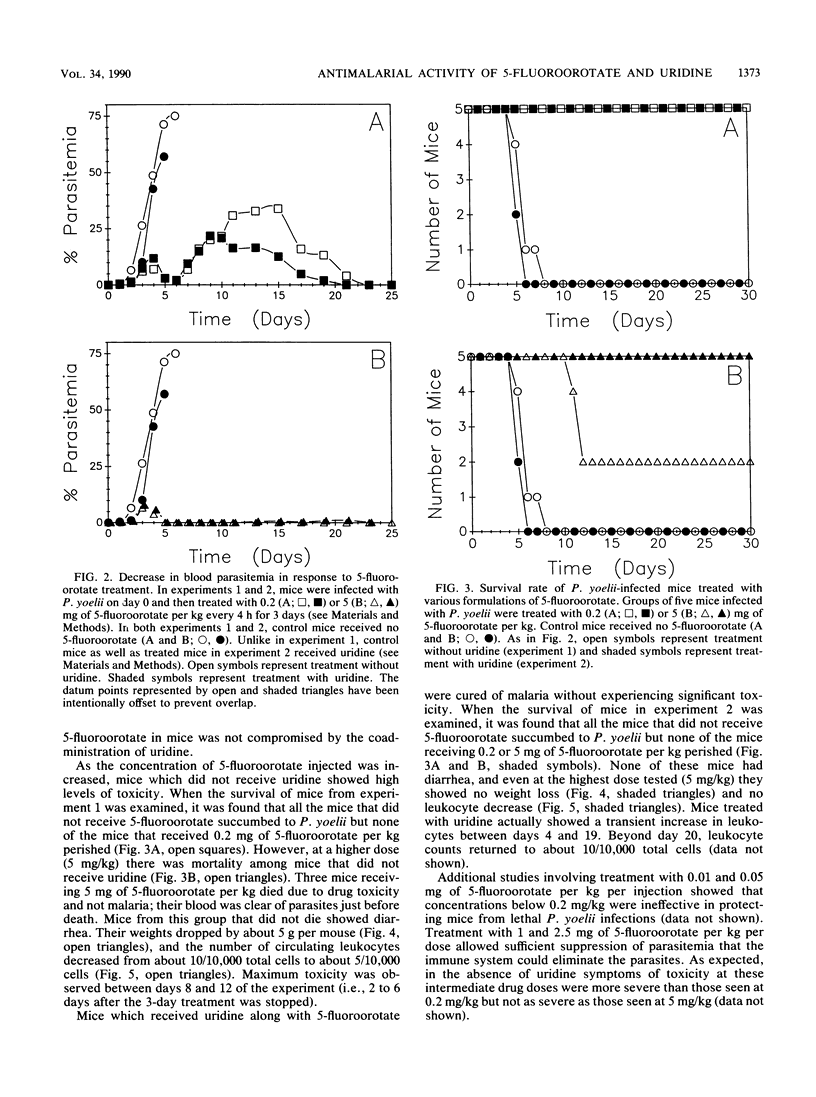Abstract
Malarial parasites, in contrast to mammalian cells, utilize orotic acid more efficiently than uracil or uridine. Recently, chloroquine-susceptible and chloroquine-resistant clones of Plasmodium falciparum were shown to be inhibited by 5-fluoroorotate, with a 50% inhibitory concentration of 6 nM in vitro. Mammalian cells were far less sensitive to 5-fluoroorotate, particularly in the presence of uridine. In this report, the antimalarial activity of 5-fluoroorotate was tested in vivo. Initially, levels of 5-fluoroorotate in plasma were determined in Swiss mice injected intraperitoneally with radioactive 5-fluoroorotate. On the basis of the pharmacokinetics profile, mice infected with Plasmodium yoelii were treated with 5-fluoroorotate at a dose of 0.2 or 5 mg/kg (body weight) every 4 h for 3 days. At the nontoxic dose of 0.2 mg/kg, the reduction in parasitemia was followed by a temporary resurgence of parasitemia. This second wave of parasitemia cleared without additional 5-fluoroorotate treatment. To radically eliminate P. yoelii from mice and avoid the second wave of parasitemia, a higher dose of 5 mg of 5-fluoroorotate per kg had to be used. In the absence of uridine, repeated doses of 5 mg/kg were toxic to mice, as judged by weight loss, diarrhea, decreased numbers of leukocytes, and increased mortality. However, in the presence of uridine, repeated doses of 5 mg/kg could be used for antimalarial chemotherapy without obvious toxicity. Mice cured with 5-fluoroorotate and uridine were immune to subsequent challenge with a potentially lethal inoculum of P. yoelii.
Full text
PDF




Selected References
These references are in PubMed. This may not be the complete list of references from this article.
- BOSCH L., HARBERS E., HEIDELBERGER C. Studies on fluorinated pyrimidines. V. Effects on nucleic acid metabolism in vitro. Cancer Res. 1958 Apr;18(3):335–343. [PubMed] [Google Scholar]
- CHAUDHURI N. K., MONTAG B. J., HEIDELBERGER C. Studies on fluorinated pyrimidines. III. The metabolism of 5-fluorouracil-2-C14 and 5-fluoroorotic-2-C14 acid in vivo. Cancer Res. 1958 Apr;18(3):318–328. [PubMed] [Google Scholar]
- Gutteridge W. E., Trigg P. I. Incorporation of radioactive precursors into DNA and RNA of Plasmodium knowlesi in vitro. J Protozool. 1970 Feb;17(1):89–96. doi: 10.1111/j.1550-7408.1970.tb05163.x. [DOI] [PubMed] [Google Scholar]
- HEIDELBERGER C., GRIESBACH L., MONTAG B. J., MOOREN D., CRUZ O., SCHNITZER R. J., GRUNBERG E. Studies on fluorinated pyrimidines. II. Effects on transplanted tumors. Cancer Res. 1958 Apr;18(3):305–317. [PubMed] [Google Scholar]
- Houghton J. A., Houghton P. J., Wooten R. S. Mechanism of induction of gastrointestinal toxicity in the mouse by 5-fluorouracil, 5-fluorouridine, and 5-fluoro-2'-deoxyuridine. Cancer Res. 1979 Jul;39(7 Pt 1):2406–2413. [PubMed] [Google Scholar]
- Jones M. E. Pyrimidine nucleotide biosynthesis in animals: genes, enzymes, and regulation of UMP biosynthesis. Annu Rev Biochem. 1980;49:253–279. doi: 10.1146/annurev.bi.49.070180.001345. [DOI] [PubMed] [Google Scholar]
- Leyva A., van Groeningen C. J., Kraal I., Gall H., Peters G. J., Lankelma J., Pinedo H. M. Phase I and pharmacokinetic studies of high-dose uridine intended for rescue from 5-fluorouracil toxicity. Cancer Res. 1984 Dec;44(12 Pt 1):5928–5933. [PubMed] [Google Scholar]
- Martin D. S., Stolfi R. L., Sawyer R. C., Spiegelman S., Young C. W. High-dose 5-fluorouracil with delayed uridine "rescue" in mice. Cancer Res. 1982 Oct;42(10):3964–3970. [PubMed] [Google Scholar]
- McCormick G. J., Canfield C. J., Willet G. P. In vitro antimalarial activity of nucleic acid precursor analogues in the simian malaria Plasmodium knowlesi. Antimicrob Agents Chemother. 1974 Jul;6(1):16–21. doi: 10.1128/aac.6.1.16. [DOI] [PMC free article] [PubMed] [Google Scholar]
- Moyer J. D., Malinowski N., Ayers O. Salvage of circulating pyrimidine nucleosides by tissues of the mouse. J Biol Chem. 1985 Mar 10;260(5):2812–2818. [PubMed] [Google Scholar]
- Payne D. Spread of chloroquine resistance in Plasmodium falciparum. Parasitol Today. 1987 Aug;3(8):241–246. doi: 10.1016/0169-4758(87)90147-5. [DOI] [PubMed] [Google Scholar]
- Rathod P. K., Khatri A., Hubbert T., Milhous W. K. Selective activity of 5-fluoroorotic acid against Plasmodium falciparum in vitro. Antimicrob Agents Chemother. 1989 Jul;33(7):1090–1094. doi: 10.1128/aac.33.7.1090. [DOI] [PMC free article] [PubMed] [Google Scholar]
- Sherman I. W. Biochemistry of Plasmodium (malarial parasites). Microbiol Rev. 1979 Dec;43(4):453–495. doi: 10.1128/mr.43.4.453-495.1979. [DOI] [PMC free article] [PubMed] [Google Scholar]
- Weber G., Shiotani T., Kizaki H., Tzeng D., Williams J. C., Gladstone N. Biochemical strategy of the genome as expressed in regulation of pyrimidine metabolism. Adv Enzyme Regul. 1977 Oct 3;16:3–19. doi: 10.1016/0065-2571(78)90064-x. [DOI] [PubMed] [Google Scholar]


